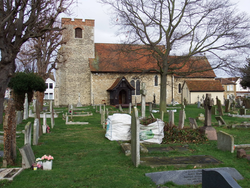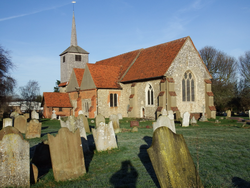
The Corpus of ROMANESQUE SCULPTURE in Britain & Ireland

Southend-on-Sea (now)
Parish church
Shoeburyness is a town on the N bank of the Thames estuary, 3 miles E of the centre of Southend-on-Sea and forming the eastern end of the Southend conurbation. South Shoebury is the part of Shoeburyness nearer the coast, and borders the MOD Shoeburyness site to the E, which provides testing and evaluation of weapons systems. St Andrew's stands in an urban setting and consists of a chancel with a S vestry, nave with S porch and W tower. The nave and chancel are 12thc, the tower dates from the 14thc with later brick battlements, the timber porch is 15thc work and the plain rendered vestry was built by volunteer labour in 1902. Construction is of ragstone and flint rubble. The church was restored by W. Slater c.1857, and by Nicholson, c.1894-1902. The 12thc chancel arch is flanked by later medieval arches on the E and the N and S nave walls, perhaps indicating the presence of nave altars, and the remains of a rood stair survive on the N side. Romanesque features recorded here are the N and S nave doorways, chip-carved windows on the N and S walls of the chancel, a reset corbel on the S chancel wall and the chancel arch. The font is in a 12thc style but must date from Nicholson's restoration.
Parish church
Eastwood is a suburbe of Southend on the N side, dominated by Southend Airport. St Laurence's is in an unpromising position at the SW corner of the airfield, at the end of the longer runway, alongside an industrial estate, but it is a large and active parish and the church has a very large graveyard on the N side. It consists of a chancel and a nave with a wide S aisle roofed with a double gable and a S porch. The aisle occupies only the E end of the nave, and at its W end is a tower with a weatherboarded upper stage topped by a needle spire. On the N side of the nave is a narrow aisle with a N vestry at its W end. The nave is Norman (see the remains of round-headed windows above the arcade). This arcade consists of two widely separated bays with much blank wall remaining, and dates from the 14thc. Lancets in the chancel and the lower part of the tower indicate a 13thc date for these features, and the A nave arcade must date from c.1300. The 2 gables of the S aisle suggest a widening in the 16th - 17thc, and the brick S porch must be contemporary. The church was restored by William Wite in 1873, and the N vestry was added in 1966. The only Romanesque feature recorded here is the font, although as Bettley (2007) points out, the ironwork nave doors of 1170-80 are what the church will be chiefly visited for.
Museum, formerly Cluniac priory
Prittlewell is a suburb of Southend-on-Sea, on its northern outskirts. The Priory was a Cluniac foundation, founded c.1110 and dissolved in 1536, after which it was converted to domestic use. The priory and grounds were presented to the town in 1917, and opened as a museum in 1922. The only standing remains of the monastic buildings are the S and W ranges of the cloister, which stood to the S of the piriory church. These formed the basis of the domestic building to which it was converted after the Dissolution. The W range dates from the 15thc and include the priors' lodging; which the late-12thc refectory occupied the S range. It was restored and partly rebuilt in the early 20thc, but the N wall is largely original and includes a doorway and a rebuilt window, described below.


